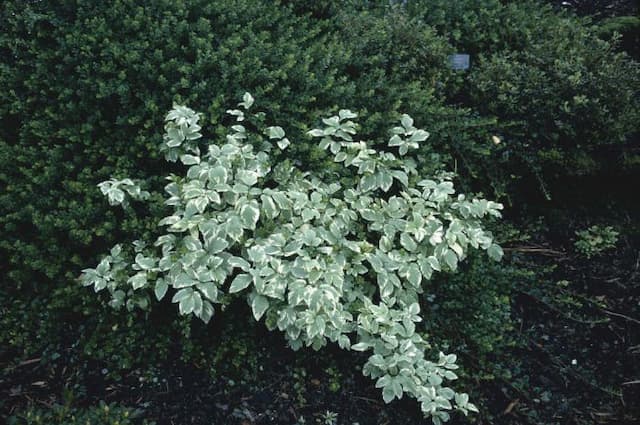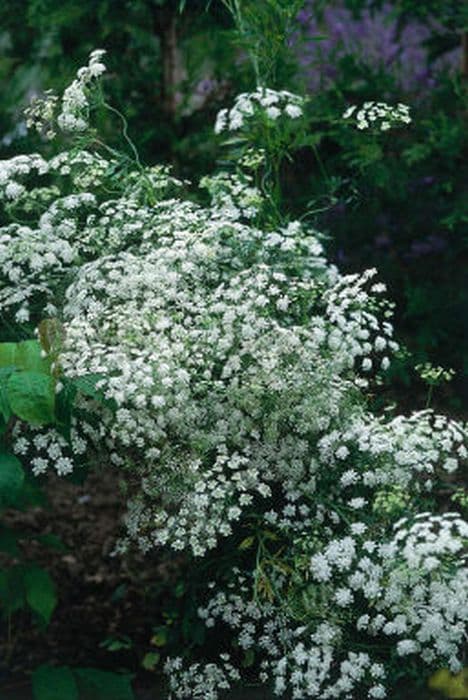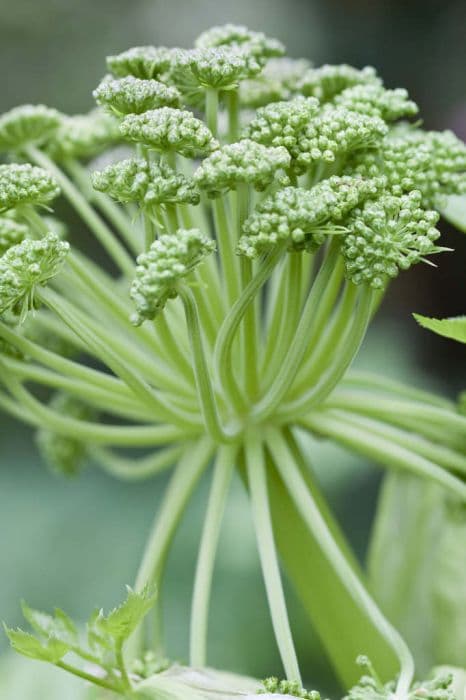Masterwort 'Sunningdale Variegated' Astrantia major 'Sunningdale Variegated' (v)

ABOUT
'Sunningdale Variegated' is an herbaceous perennial to 75cm, with palmately divided leaves broadly margined with creamy-yellow. Branching stems bear heads of small flowers surrounded by showy pink-tinged white bracts
About this plant
 Names
NamesFamily
Apiaceae
Synonyms
Great Masterwort, Masterwort
Common names
Astrantia major 'Sunningdale Variegated'
 Characteristics
CharacteristicsLife cycle
Perennials
Foliage type
Deciduous
Color of leaves
Variegated
Flower color
Pink
Height
2 feet (60 cm)
Spread
2 feet (60 cm)
Plant type
Herb
Hardiness zones
5
Native area
Europe
Benefits
 General Benefits
General Benefits- Attractive Foliage: The variegated leaves of Astrantia major 'Sunningdale Variegated' add visual interest to gardens with their unique patterning.
- Long Blooming Season: This plant produces flowers over a long period, typically from early summer to early fall, providing a consistent display of color.
- Beneficial for Pollinators: The flowers attract bees, butterflies, and other beneficial pollinators, supporting biodiversity.
- Low Maintenance: It is known for being a low-maintenance plant, requiring minimal care once established.
- Drought Tolerance: Once established, it can tolerate periods of drought, making it suitable for gardens with drier conditions.
- Cold Hardy: Being cold hardy, it can survive in colder climates and does not need extensive winter protection.
- Deer Resistant: The plant is generally resistant to deer, which can be an advantage in areas where deer predation is a problem.
- Cottage Garden Appeal: Its old-fashioned charm is ideal for cottage-style gardens and informal planting schemes.
- Works Well in Mixed Borders: It can be easily combined with other perennials in mixed borders for a varied garden design.
- Cut Flower Use: The flowers make excellent cut flowers for arrangements, with a good vase life.
 Medical Properties
Medical PropertiesThis plant is not used for medical purposes.
 Air-purifying Qualities
Air-purifying QualitiesThis plant is not specifically known for air purifying qualities.
 Other Uses
Other Uses- Pressed Flower Art: Astrantia can be pressed and preserved to create ornamental designs for framed art or greeting cards, retaining color and structure quite well.
- Natural Dyes: The roots and flowers of the Masterwort, when boiled, can be used to produce natural dyes for fabrics and yarns in subtle shades.
- Educational Resource: Masterwort plants can be used in school projects or educational gardens to teach about native plant species and biodiversity.
- Photography Subject: With its unique appearance, Masterwort provides an excellent subject for botanical photography, helping hobbyists or professionals capture the beauty of plant detail.
- Fairy or Miniature Gardens: Due to its intricate flowers, Masterwort is well suited for inclusion in fairy gardens, offering a magical appeal to small-scale, whimsical landscapes.
- Floral Arrangements: The flowers of Masterwort can be dried and included in long-lasting, dry floral arrangements to provide texture and interest.
- Garden Borders: The variegated foliage of 'Sunningdale Variegated' can be utilized to create contrasting edges and highlights in garden borders.
- Companion Planting: Masterwort can be planted along with other perennials to support ecological gardening practices, fostering a habitat for beneficial insects.
- Culinary Garnish: Although not widely recognized, Masterwort flowers could be used as unique, edible garnishes on special dishes, particularly in haute cuisine.
- Craft Material: The sturdy stems and seed heads of Masterwort can be used in craft projects, such as in the creation of natural wreaths or as part of mixed-media artwork.
Interesting Facts
 Feng Shui
Feng ShuiThe Masterwort is not used in Feng Shui practice.
 Zodiac Sign Compitability
Zodiac Sign CompitabilityThe Masterwort is not used in astrology practice.
 Plant Symbolism
Plant Symbolism- Protection: Throughout history, Astrantia major (Great Masterwort), has been thought to symbolize protection. This is partly because it was believed to have medicinal properties that could ward off harm.
- Secrets and Mystery: The intricate patterns and shapes of the Great Masterwort flowers suggest hidden depths and complexities, leading to associations with secrecy and the unknown.
- Perseverance and Strength: Great Masterwort is known for its hardiness and ability to thrive in challenging conditions, thus representing the qualities of perseverance and strength in the face of adversity.
- Unity and Togetherness: The cluster of tiny flowers that form the head of the Great Masterwort bloom can be seen to represent unity and togetherness, with each part contributing to the beauty and completeness of the whole.
 Water
WaterGreat Masterwort requires consistent moisture, so it's essential to keep the soil lightly moist but not waterlogged. Water the plant once or twice a week with about 16-24 ounces of water, depending on your local climate and the time of year. During hot, dry periods, more frequent watering may be necessary to prevent the soil from drying out completely. Conversely, in cooler, wetter climates or seasons, watering frequency should be reduced. Always check the top inch of soil for dryness before watering and adjust your schedule accordingly.
 Light
LightGreat Masterwort thrives best in partial shade to full sun. The ideal spot for the plant would be an area that receives morning sunlight and is shaded during the hottest part of the day to protect its variegated foliage from scorching. Filtered light throughout the day is also suitable and can help the leaves maintain their vibrant colors.
 Temperature
TemperatureGreat Masterwort prefers temperatures between 50°F and 75°F, which are typically found in temperate climates. The plant can survive temperatures as low as 30°F for brief periods, but prolonged exposure to temperatures below freezing can be damaging. During the hottest parts of summer, it's crucial to ensure that the plant is not subjected to temperatures exceeding 80°F for an extended period, as this can lead to stress.
 Pruning
PruningPruning Great Masterwort is done to remove spent flower stems and to shape the plant. Deadheading the faded flowers can encourage a second bloom and maintain the plant's appearance. Cut back the entire plant by about a third after flowering has ceased, which typically is in late summer or early fall. Pruning encourages fresh growth and can be repeated every few years to rejuvenate older plants.
 Cleaning
CleaningAs needed
 Soil
SoilGreat Masterwort prefers soil that's moist, fertile, and well-draining, with a good amount of organic matter. A blend of loamy garden soil, compost, and some perlite or sand to ensure drainage will serve the Great Masterwort well. The ideal soil pH for the Great Masterwort should be slightly acidic to neutral, ranging from about 6.0 to 7.0.
 Repotting
RepottingGreat Masterwort doesn't need frequent repotting and can typically be repotted every 2 to 3 years. It's best to repot Great Masterwort plants in the spring just before new growth starts. Ensure the new pot is larger and has good drainage.
 Humidity & Misting
Humidity & MistingGreat Masterwort thrives in average to high humidity conditions. It does not have specific humidity requirements but benefits from a consistent level of moisture in the air, mimicking its natural habitat in moist meadows and by streams.
 Suitable locations
Suitable locationsIndoor
Ensure adequate light, moist soil, and good air circulation.
Outdoor
Plant in partial shade, moist soil, and protect from harsh winds.
Hardiness zone
4-7 USDA
 Life cycle
Life cycleThe life of Astrantia major 'Sunningdale Variegated', commonly known as Great Masterwort, begins with seed germination in spring, provided the seeds have undergone a period of cold stratification to break dormancy. Seedlings emerge and develop into rosettes of variegated green and cream leaves, with mature plants forming clumps up to 90 cm in height and width. During late spring to midsummer, the plant produces distinctive pincushion-like flowers with bracts that can range in color from pink to white, attracting pollinators such as bees and butterflies. After flowering, seeds are produced and dispersed, which can germinate to form new plants if conditions are favorable. In autumn, the foliage may die back, and the plant enters a period of dormancy over winter, with the root system remaining alive underground. The following spring, the plant resumes growth from the rootstock, completing its perennial cycle.
 Propogation
PropogationPropogation time
Spring-Early Summer
Propogation: Astrantia major 'Sunningdale Variegated', commonly known as Masterwort, is often propagated through division, which is a popular and effective method for this perennial plant. The best time for dividing Masterwort is in the spring or early fall when the plant is not in active bloom. To propagate by division, carefully dig up the entire plant, making sure to keep a good amount of soil around the roots. Using a sharp spade or knife, slice through the root ball to separate it into smaller sections, each containing several shoots and a portion of the root system. These sections can then be replanted immediately at the same depth they were originally growing, spaced about 18 inches (approximately 45 cm) apart to allow for spreading. Water the newly planted divisions well to help them establish.









